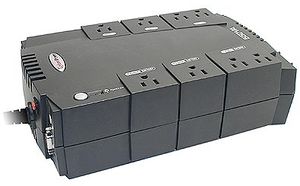Power Options
In building your cabinet, you might forget that a PC is running at the heart of it and you don't want to be opening it up each time to turn it on. Also, you may want your cabinets' components (PC, monitor, speakers, marquee light etc.) to power on and off simultaneously with each other, to add to the illusion of a real arcade machine. Depending on what operating system you are using, simply unplugging the PC may cause problems if the operating system is not given time to properly power down.
There are several options to consider...
'Smart' Power Strips
A popular approach is to use a Smartstrip or similar 'smart switching' power strip. Smartstrips can provide constant power to some components just like a normal power strip, but their most attractive feature is their automatic switching ability.
One component (typically your PC) is plugged into the blue 'Control' outlet. Other cabinet components are plugged into the switched outlets; these components will remain unpowered until your PC (or whatever is plugged into the blue Control outlet) is switched on. This means that all components will power on when your PC is switched on, and more importantly once your PC completes its shutdown procedure the other components will automatically power off. Using your PC's power switch to turn on and off all components of your cabinet in this way is probably the most popular option for PCs running modern operating systems.
Alternatives to the Bits Ltd. Smartstrip include the Mini Power Minder and the PowerMite DD (sold by BYOAC member Whammoed).
A simple relay and USB cable can be added to most regular power strips to add 'smart' functionality to them. When a voltage is detected in the USB cable, the relay supplies power to the outlets (see CrashWGs forum thread for more details). However considering the effort required, it may be wiser to go for a retail option.
Uninterruptible Power Supplies (UPS's)
Generally regarded as the safest way of doing things, though not necessarily the cheapest, is to use a small Uninterruptible Power Supply (UPS) in your cabinet. Typically UPS's are used as a simple way of providing temporary battery backup power if your computer should unexpectedly loose power, they also protect against power spikes.
Many UPS's include a USB functionality that can safely initiate your computers shutdown procedure once power has been cut to the cabinet; the computer will run on the UPS's battery power until it has shut down. When used in an arcade cabinet this means that you can just pull the plug on the whole cabinet and the computer will then safely shut down.
Standard Power Strips
Another approach is to use a regular power strip and, again, hacking an extended-wire intermittent switch to where the strip's switch is, and mounting that somewhere on the cabinet. Then, in the computer's bios settings, 'power on after interrupt' or something of that nature is selected. When power is restored, by turning the strip on, the computer senses this and turns on.
This solution is recommended for DOS based PCs that don't require a shutdown procedure such as Windows based PCs. The computers hard drive can also be damaged ff the computer is writing information to its hard drive when power is cut.
The Power Switch
Once you've determined the best power solution for your situation, the final step is to wire in an extended switch from where the original button within the front of the computer case is connected and mounting it somewhere on the surface of the cabinet. (One could also possibly situation their computer such that it's front is up against a wall inside the cabinet, and then a small hole can be made to easily access the button.)

